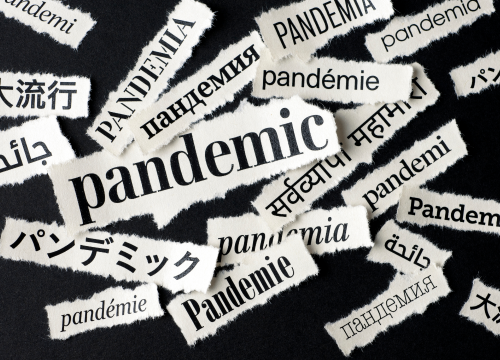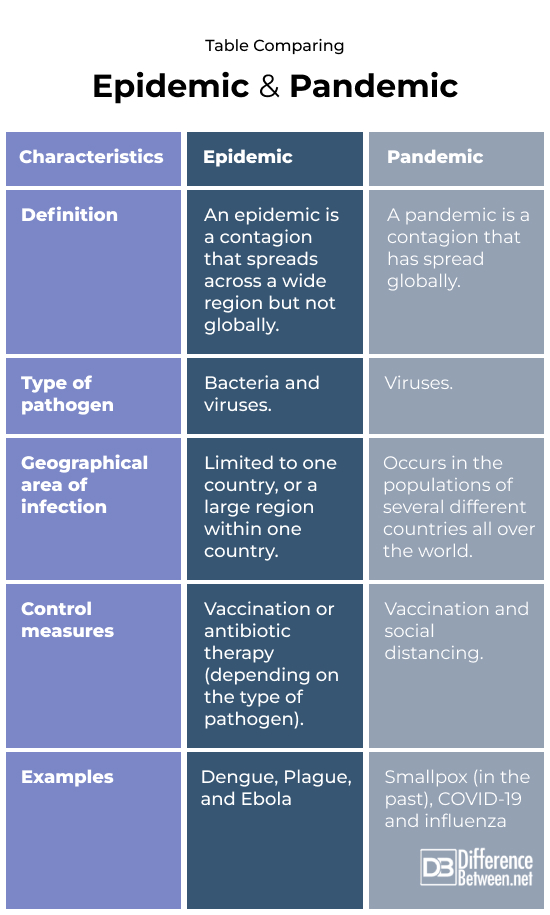Difference Between Epidemic and Pandemic
Epidemics and pandemics are both terms used to describe diseases that spread beyond a small group of people to infect many in the population. However, while an epidemic is limited in geographic extent, a pandemic is when the infection spreads far and wide. Epidemics need to be brought under control and the infection halted before it spreads to other countries and develops into pandemic status.
Pandemics are more economically devastating since the contagion spreads to people in many countries of the world, having a negative global impact on all aspects of trade. This has consequences such as increased prices on goods, making times more difficult for people with limited finances.
In short, epidemics are widespread contagions that need to be rapidly contained to prevent global spread. Once an illness reaches pandemic status, the death rate increases and it has a negative impact on multiple countries.

What is an Epidemic?
Definition:
An epidemic is an outbreak of a disease that suddenly occurs in a particular region and population but does not occur globally. An endemic illness can become an epidemic if the number of cases and spread of the illness is more than usual. Epidemic illnesses spread fast through a population and need to be carefully monitored so that the spread does not go beyond the country’s borders.
Epidemics are often viral infections that are very contagious, and easily transmitted from one person to another. It is important to note that epidemics do also occur in animal populations from time to time, which can have unexpected economic consequences as well. For instance, avian influenza in South Africa caused egg prices to drastically increase due to many chickens dying. Bacterial epidemics are also possible but are easier to control because doctors can give antibiotics to kill the pathogen.
Examples:
In humans, the Ebola virus has caused epidemics in parts of Africa between 2013 and 2016 in Africa. The virus affected people in at least three countries in Africa. The high and quick mortality of the Ebola virus and its method of transmission via body fluids and not respiratory droplets, has stopped the pathogen spreading too far and reaching pandemic status. Past epidemics have included the bubonic plague in Europe, which killed millions of people.

What is a Pandemic?
Definition:
A pandemic is when a disease spreads globally, with people in multiple countries being infected. It is usually a virus that causes a pandemic as these pathogens cannot be controlled by antibiotics, and can be easily transmitted. Scientist do think, however, that it is possible that there may be bacterial infections causing pandemics in the future. Multi-drug resistance bacteria that cannot be easily controlled with antibiotic therapy may result in future pandemics.
Examples:
The most obvious example of a pandemic is that of COVID-19 in which a type of coronavirus entered the population and spread rapidly to infect people on nearly every continent. The disease was easily transmitted through people coughing and sneezing. Other examples include influenza.
Every year, the influenza virus spreads throughout the world, and, although vaccination can help, many people are still affected. The flu is also a respiratory virus that is easily transmitted by droplets. The concern now, is that the avian influenza may one day become a global pandemic. To date, other strains of flu have been responsible for human pandemics. Besides the mortality of pandemic illnesses, they also have economic consequences. This is because countries may limit air travel and the arrival of goods through ports.
Difference between Epidemic and Pandemic?
Definition
An epidemic is a contagious disease that spreads across a wide region but not globally. A pandemic is a contagion that has spread globally.
Type of pathogen
Bacteria and viruses cause epidemics. Pandemics, in recent times, are caused by viruses.
Geographical area of infection
Epidemics are limited geographically to one large region in a country or to a few countries in the same general area. Pandemics are diseases that have spread to multiple countries throughout the world.
Control measures
Epidemics are controlled by antibiotics or vaccination. Pandemics are controlled by social distancing and vaccination.
Examples
Examples of epidemics include the plague, dengue, and Ebola. Examples of pandemics include smallpox (in the past) and, more recently, COVID-19 and influenza.
Table comparing Epidemic and Pandemic

Summary of Epidemic Vs. Pandemic
- An epidemic is a contagious infection that has spread to infect many individuals over a large region but not globally.
- A pandemic is when a contagion has spread far and wide to infect many people in multiple countries around the world.
- If an epidemic is not controlled, it can spread and become a pandemic.
FAQ
What is an example of an epidemic?
Ebola in parts of Africa has reached epidemic status before, where the virus did not spread globally but was affecting people over a fairly large region.
What disease killed the most humans in history?
The bubonic plague (commonly called the black death) caused the most human deaths in history.
What is the difference between an epidemic and a pandemic?
An epidemic is a contagion that makes many people sick within a specific region of the world. A pandemic is when an epidemic has spread further to infect people all over the world.
What is a pandemic, give an example?
A pandemic is a contagious illness that has spread globally. COVID-19 is an example of a pandemic.
What is more severe pandemic or epidemic?
A pandemic is more severe in terms of sheer impact, both on mortality and economics.
How do pandemic and endemic compare?
An endemic illness is one that normally occurs in a particular area. A pandemic illness is not an endemic illness but rather a new contagion that spreads rapidly around the world.
Was the bubonic plague a pandemic or epidemic?
Bubonic plague was limited to Europe, and was thus considered an epidemic.
Is Ebola an endemic?
Ebola is now considered endemic to some countries in West Africa and East-Central Africa.
What are the main causes of epidemics?
Epidemics are caused by contagious pathogens that are easily transmitted. There may be an increase in epidemics in crowded populations and due to cultural influences (such as washing a deceased Ebola patient leading to infection). War can also lead to epidemics due to unsanitary conditions.
- Difference Between Constipation and Bowel Obstruction - April 3, 2024
- Difference Between Constipation and Diarrhea - March 30, 2024
- Difference Between Cellulite and Stretch Marks - March 25, 2024
Search DifferenceBetween.net :
2 Comments
Trackbacks
- Difference between Cold and Flu | Difference Between
- Difference between Cold and Flu | Difference Between
Leave a Response
References :
[0]Kuiken, Thijs, Ron AM Fouchier, and Marion PG Koopmans. "Being ready for the next influenza pandemic?" The Lancet Infectious Diseases 23.4 (2023): 398-399.
[1]Mayo Clinic. “Endemic vs. epidemic vs. pandemic: What you need to know, Mayo Clinic, 2023, https://www.mayoclinichealthsystem.org/hometown-health/featured-topic/endemic-epidemic-pandemic
[2]Van Duin, David, and David L. Paterson. "Multidrug-resistant bacteria in the community: trends and lessons learned." Infectious disease clinics 30.2 (2016): 377-390.
[3]Image credit: https://www.canva.com/photos/MAEYGjzC_-I-viral-disease-epidemic-end-concept-/
[4]Image credit: https://www.canva.com/photos/MAEFgxa0rT0-bad-news-pandemic/
